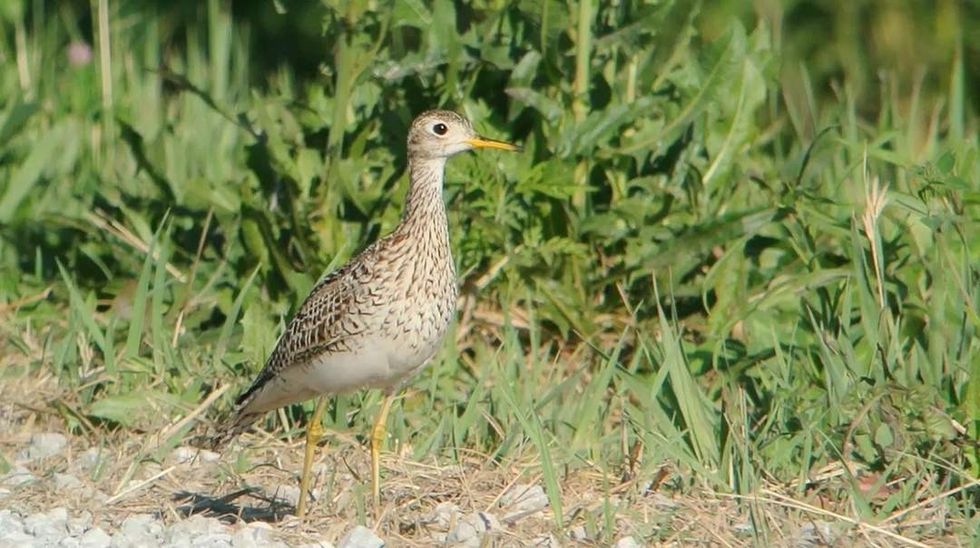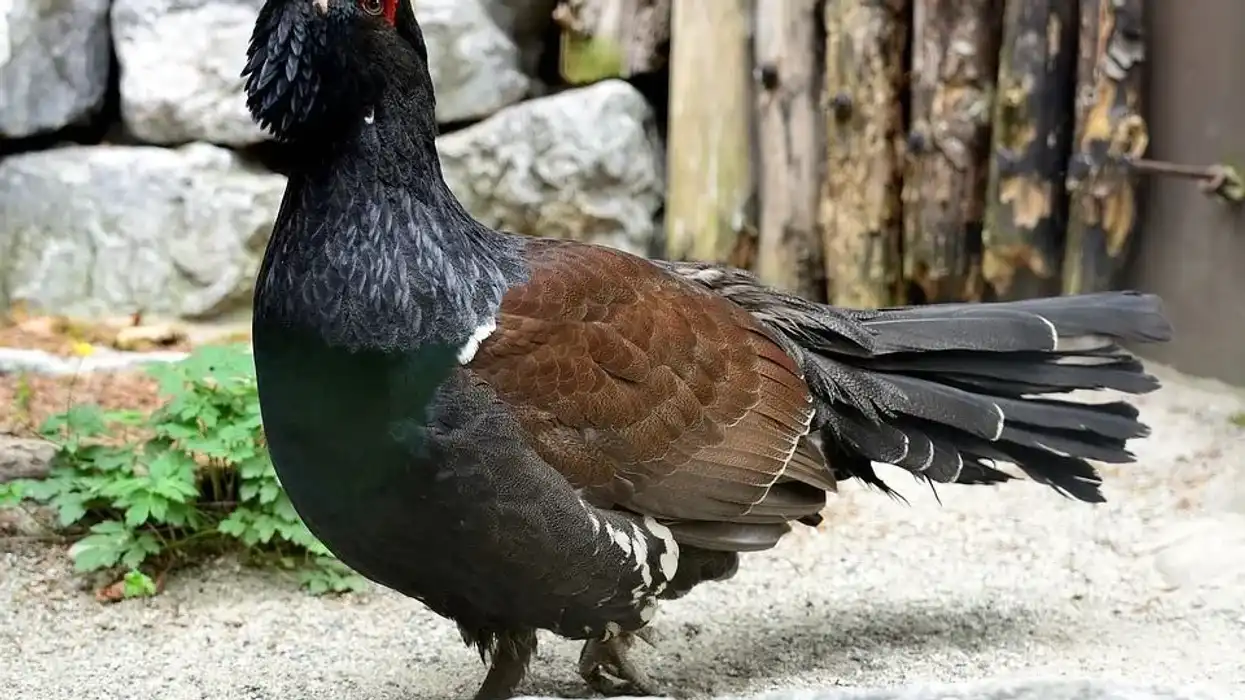In recent times, upland sandpipers have their conservation ground protected under the Migratory Bird Treaty Act. These birds prefer to live in7 open grassland and carry out their nesting on the ground amidst tall grasses, unlike the other North American shorebirds.
Their breeding season occurs between late April and early May months. Their population is known to migrate during winter as well as spring and fall as the birds live on different grassland sites or locations favorable for their habitat in those seasons.
These birds have long necks, tails, and small bills. Their body is usually a mottled mix of dark-brown and white spots.
They forage on short grass and are frequently seen on or near the grass in airports or on open lands in recent times. Their nest is usually close to another nest of birds of their species. This vicinity might even be mistaken as a colony during the nesting period.
Even though they aren't territorial, the breeding pair does not allow single males to come close to their nest. Read on to know more about these sandpipers' habitat, nest, breeding, and migrating facts.
For more information about other animals check out these jacana facts and song thrush facts.
Upland Sandpiper Interesting Facts
What type of animal is an upland sandpiper?
Upland sandpipers are birds that belong to the order Charadriiformes, family Scolopacidae of animals.
What class of animal does an upland sandpiper belong to?
These North American birds belong to the Aves class of animals.
How many upland sandpipers are there in the world?
Even though these birds have been marked as threatened in the bird conservation list of a few regions, the natural wildlife research center has a record of around 750,000 upland sandpipers across the world. This species is protected exclusively under the Migratory Bird Treaty Act to reduce their hunting fatalities.
Where does an upland sandpiper live?
This species of bird live in the grasslands and prairie grounds of North America, South America, northern Texas, Oklahoma, New Zealand, Alaska, New England, as well as Australia.
What is an upland sandpiper's habitat?
Most North American shorebirds prefer the wetlands as their habitat. Although these North American birds of the order Charadriiformes family are usually spotted in open fields and grasslands. This species might also be spotted on agricultural lands, pastures with short grass, and prairie grounds.
These birds follow their long-distance migration cycle during the winter season. The birds migrate towards the wintering areas of southern South America or to the Great Plains. They even stop on pastures and prairie lands for a break during their long-distance migration.
Who do upland sandpipers live with?
These birds are not territorial and may be okay with other birds of their species meddling within their space. Hence, during the breeding season, they have their nests quite close to each other. The placements of the nest are so close to their breeding range that many times they are even considered colonies.
How long does an upland sandpiper live?
This bird with an almost threatened bird conservation population in a few regions of North America has a life expectancy of around five years. The oldest bird of this species that has been recorded was in New York. This bird had lived for eight years and 11 months.
How do they reproduce?
Upland sandpiper males attract females by perching on the fence posts between late April and early May.
Males are known to hover over their breeding grounds engaging in their flight calls and landing on the vegetation by raising their wings back and showing off their long tails. This species is usually monogamous, although there have been a few males who were observed to father multiple broods.
Once the male and female get together, they perform a few acts of flying together, hovering over their nesting area together, and singing their song calls to display their bond.
After, the mating pairs will make their nest on the ground in the dense grassland or vegetation sites. These nests on the grasslands are scrapes in the ground lined with dry grass, twigs, and leaves.
The nesting range has nests that are usually close to each other. This is mainly because the nesting process for all the breeding pairs of this species happens at the same time.
The female then lays around two to seven eggs in the nest. Their nesting process goes on for two months where both parents incubate the eggs for 21-29 days. After that, young birds hatch from the eggs and are cared for by both parents for another month.
During this span, young sandpipers move around on the nesting grasslands and in the vegetation to feed themselves. After a month, the young birds take their first flight and leave the nest to live independently.
What is their conservation status?
These birds of the northern areas are considered of Least Concern by the International Union for Conservation of Nature (IUCN). Although, due to hunting practices, the 'upland sandpiper endangered' signs are not uncommon for their population in certain parts of their habitat
Upland Sandpiper Fun Facts
What do upland sandpipers look like?

The upland sandpiper, Bartramia longicauda, is unlike similar species of shorebirds in behavior but might have a similar physical description as them. This bird has a mottled brown-black-white body with a long tail and a long neck. The bird has a round and small head with naturally big eyes.
When in flight, this bird shows paler inner wings that have dark outer parts. The bill is yellow and smaller than the other sandpipers. The legs have a medium length and are yellowish-brown and thin.
How cute are they?
Although upland sandpipers have a dove-like appearance, one may not be able to qualify them as cute birds.
How do they communicate?
These birds are highly vocal in their communication patterns. The upland sandpiper call and song during the breeding period are usually whistle-like "hu-hee-he" sounds.
They also have tattler calls like "kip-ip-ip" that they might also use in case of alarm calls. Apart from vocalization, males use their body movements like perching on the fence posts and showing their tails to attract females during the breeding period.
How big is an upland sandpiper?
Upland sandpipers are twice the size of least sandpipers. Their body length has a range of 11.0-12.6 in (28-32 cm) and their wingspan might range up to 18.5 in (47 cm).
How much does an upland sandpiper weigh?
Sandpipers are usually confused with other shorebirds and have a weight range of 3.4-8.0 oz (97-226 g).
What are the male and female names of the species?
The upland sandpiper range of birds does not have distinctive names for males and females.
What would you call a baby upland sandpiper?
The young sandpiper is called a peep.
What do they eat?
These birds have an omnivorous diet ranging from snails, earthworms, grasshoppers, crickets, flies, spiders, ants, and beetles to grains, grasses, and seeds too. These birds are known to forage in the grassland or on the agricultural ground with small grass that suits their habitat conditions.
Would they make a good pet?
This bird population enjoys living amidst wildlife on the natural grassland and open meadows. Hence, keeping these young or adult birds as pets is not advisable because they wouldn't make good pets.
Did you know...
The conservation of upland sandpipers is of the least concern. Even then, this species is recorded as an endangered species on the lands of Pennsylvania, New Jersey, and many other North American regions since 1985. The reasons have been noted as loss of favorable grassland and conservation ground, hunting history, and lack of suitable habitat conditions.
How did the upland sandpiper get its name?
In the early days, this species was also known as upland plover due to its round head and small bill. Later, based on the upland sandpipers' physical description which was unlike other shorebirds, it was renamed the upland sandpiper and was scientifically named after William Bartram.
The bird was named upland sandpiper, Bartramia longicauda, with longicauda meaning ‘long tail’ in Latin, which aptly describes their natural appearance.
What are sandpipers known for?
Sandpiper species of birds are known for their wide variety of around 50+ species. Additionally, these birds are considered a symbol of the quality of problem-solving.
This is mainly due to their migration skills and the idea of traveling to wintering areas to live in the most suitable, natural conditions. They achieve their favorable wildlife conditions by the act of migration even if they have to travel for long distances to do so.
Here at Kidadl, we have carefully created lots of interesting family-friendly animal facts for everyone to discover! For more relatable content, check out these Grey Partridge facts and Bowerbird facts.
You can even occupy yourself at home by drawing one on our upland sandpiper coloring pages.










